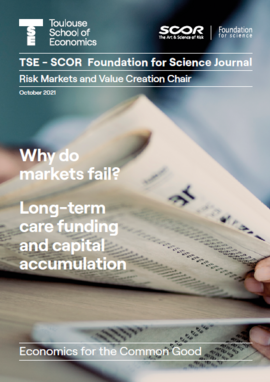Long-term care funding and capital accumulation
Analyzing the impact of alternative LTC financing methods on economic growth and longevity
3 janvier 2022

The aging of the baby boomers has been described as a demographic earthquake that will shake the foundations of the long-term care (LTC) system. Expanding on work by Pierre Pestieau (TSE, University of Liege), research by TSE’s Emmanuel Thibault, published through the TSE - SCOR Foundation ‘Risk Markets and Value Creation Chair’, addresses the question of dependency and the practice of LTC insurance via the interactions between the market, the government, and the family. This three-way interaction approach is a novel and unique way of tackling the LTC issue. He also examines the trade-offs involved when individuals must choose between proactive spending on health to improve life expectancy or (eventual) later-life LTC costs if they become old. The main objective is to analyze the impact that alternative ways of financing LTC may have on capital accumulation and, consequently, on economic growth and longevity.
Why must any reform of LTC consider the interplay between the State, the family, and the market?
In light of recent demographic, societal and financial changes, demand for formal care services for dependents has grown rapidly and continuously. Instead of being provided and funded by the market or the State, the cost of caring for the majority of dependents assisted at home is currently borne by family members. In France, almost five million people care for a dependent relative; for the majority, this task consumes an average of six hours a day. This is an increasingly unsustainable situation that requires the market and the State to provide a substitute or, at the very least, a real complement to the family contribution.
In a realistic context in which the State must interact with families and the market, it is essential first to understand what motivates family solidarity and how this is influenced by the existence of public or private insurance programs. These programs must then be given special attention, since they have an undeniable impact on the nature of the recommendations that must be considered by public policymakers.
Does private insurance help economic growth?
I recently presented a theoretical study with Chiara Canta and Pierre Pestieau that puts together the essential information required to help policymakers define the real consequences — both micro and macro — of different scenarios for LTC financing reform. This research breaks new ground by including in the same framework all possible LTC funding sources (unfunded public insurance, private insurance, family help, and precautionary savings) and their interplay, the psychological bias of the dependent towards family support, intergenerational imitation by the carer, dynamic intergenerational aspects, and the role of prices such as wages and interest rates.
As expected, the presence of family help and/or public insurance changes both individual behavior and the dynamics of capital accumulation. However, the main message is counterintuitive: In the presence of family support, individuals choose private insurance if the pay-as-you-go social insurance is generous enough; and the more generous the latter, the higher the economic growth. Thus, the fact that an aging population leads the State to establish generous unfunded public insurance also encourages individuals to insure themselves privately and is therefore beneficial for growth. This finding sheds new light on an important debate, contrasting with earlier economic studies which suggest that social LTC coverage and unfunded pension schemes discourage capital accumulation by crowding out precautionary private savings.
What is the size and impact of the costs borne by individuals?
In France, more than 20% of people over the age of 85 live in a nursing home (EHPAD). Their average out-of-pocket expenses are €1,850 per month. This exceeds their current resources in 75% of cases and highlights an unavoidable lifecycle trade-off: Invest in health capital at a young age (and thus increase your life expectancy) or save to cope with (eventual) dependency.
Using a theoretical model with endogenous longevity, I study the impact of this trade-off on individuals’ health spending, as well as on economic growth and longevity. This framework shows that savings and health expenditure are complementary. Surprisingly, the costs of dependency are therefore beneficial for growth. Although, all else being equal, these costs can reduce health expenditure, it is possible (via a general equilibrium effect) that they actually increase it. Taking into account the costs of dependency may also explain the slowdown in the increase in life expectancy in rich countries
What are the next steps for research in this area?
My hope is that future research will expand the study of multiple LTC funding channels — public and private insurance, family caregiver, and/or self-insurance — in a world with health expenses. I would also like to see a more refined interpretation of out-of-pocket LTC expenses, in terms of the probability and cost of dependency, to better target the economic impact of LTC financing policies and to distinguish life expectancy from healthy life expectancy. This issue goes beyond the economic sphere to become a public health issue: An important step would be for caregivers’ health to be taken into consideration in impact studies. Carers are indeed those who pay the ultimate price for providing LTC: Elderly spousal carers (aged 66-96) who experience caregiving-related stress have a 63% higher mortality rate than non-caregivers of the same age!
Emmanuel Thibault is a Professor at University of Perpignan and TSE researcher. Emmanuel’s research interests in public economics and macroeconomics include population economics, economics of the family, growth and fiscal policies. In 2000 his PhD entitled “Microeconomic analysis and macroeconomic effects of intergenerational transfers” received the award of “Best Thesis of the Year” from Aix Marseille University (Interdisciplinary PhD Prize).
Learn more about the TSE - SCOR Foundation
‘Risk Markets and Value Creation Chair’
Read "How to insure long-term care"
published by the TSE - SCOR Foundation
About the SCOR Foundation for Science
Created in 2011, the SCOR Corporate Foundation for Science forms part of the SCOR group's long-term commitment to research and the dissemination of risk-related knowledge. This commitment is an integral part of SCOR’s DNA, as illustrated by the Group’s tagline, “The Art & Science of Risk”. Risk is the “raw material” of reinsurance, and SCOR stays at the cutting edge of risk expertise and research through its vast network of academic institutions, as well as through the support it provides to numerous disciplines including mathematics, actuarial science, physics, chemistry, geophysics, climatology, economics, finance, and more.
